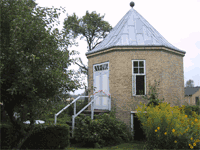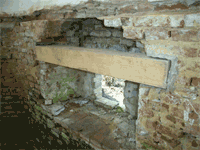Fungal attack averted despite unauthorized treatment
With the help of ProtoxSvamp a listed garden house in Museumshaven in Christiansfeld has succeeded in preventing new fungal infestations. The remarkable thing about the project is that it was not carried out in the correct craftsmanship way, in short, they jumped the gun to save money.
After removing the affected joists in the garden shed floor and a window lintel, the masonry was brushed to remove loose fungal mycelium. The masonry and abutments were then saturated with ProtoxFungal. In addition, a new, untreated window lintel was installed as a control.

| The old garden house in the museum garden |

| True House fungus in the soffit |
Three years after the repair, an inspection in early summer 2007 showed that no new infestations of powdery mildew had occurred.

Unimpregnated window lintel
added in the mushroom attack consideration

End piece of window lintel
after 3 years in bricklaying
Normally, it is costly to fight real house fungus because you have to be thorough. If you wanted to do it by the book, you should have done it that way:
All masonry is cleaned of loose plaster, joints are scraped out and half of the prescribed amount of fungicide is applied. The masonry is then grouted or taped and the other half of the fungicide is applied. New woodwork laid into masonry must be pressure impregnated (class A or equivalent) and all wooden cut surfaces must be saturated with an approved fungicide.
